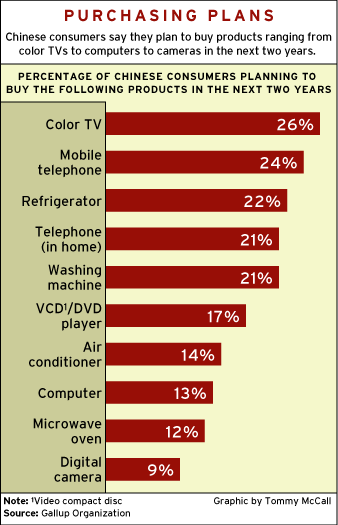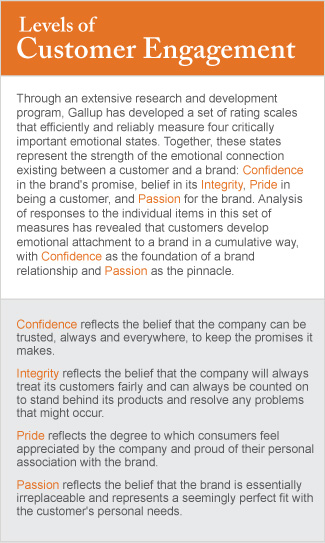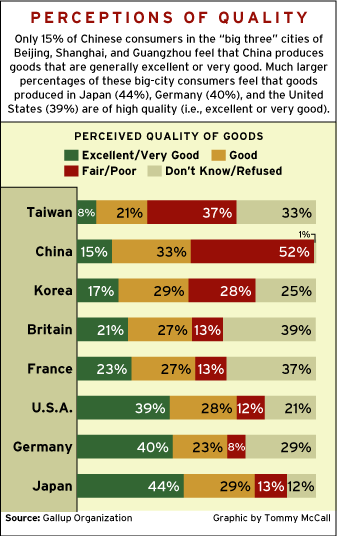China -- a land that has inspired marketers with visions of a billion people toting six-packs of Coke and tubes of Crest -- is no longer viewed as simply a huge potential market for goods produced elsewhere. Once just an attractive consumer, the country is now recognized as a capable global competitor in its own right. And it has ambitious expansion plans -- not only for Asia, but also for the United States and elsewhere.
As a result, global marketers have been paying close attention to the overseas marketing activities of Chinese manufacturers -- and those activities are moving right along. For example, Haier, a Chinese manufacturer of major appliances and electronics, has a headquarters building in New York and a major plant in South Carolina. And it's producing an impressive line of products ranging from wine cellars and microwaves to cell phones and plasma TVs. The computer and technology manufacturer Lenovo changed its brand name from "Legend" to reflect its global marketing emphasis; its stated goal is to more than triple its already-large computer business in the next five years. Consumer electronics manufacturer SVA is selling its TVs through Costco and Amazon.com, and TCL Mobile is seeking to leverage its China strength to become one of the top five mobile communications companies in the world.
 |
But as these Chinese companies prepare and plan for expansion opportunities in other lands, recent research suggests that these businesses may confront marketing problems at home. Indeed, a 2004 Gallup Organization survey of about 3,600 Chinese consumers reveals important insights into the feelings and attitudes of this huge and growing market -- and also highlights some interesting and important challenges.
Conflicting attitudes
Gallup's survey found that almost two-thirds (64%) of Chinese adults agree that they would prefer to buy products made in their own country. Only one in five (22%) lean toward buying foreign-made goods.
That would seem to bode well for Chinese manufacturers. Many Chinese consumers say they are planning to buy products ranging from computers (13% plan a purchase within the next two years) and air conditioners (14%) to mobile phones (24%) and color TVs (26%). Chinese manufacturers are well-established leaders in these areas, with strong domestic distribution networks.
Thus, companies like Heier, TCL, and Lenovo appear to be well-positioned for further growth. They have a seemingly solid foundation at home and serve huge, growing domestic markets that have expressed a strong preference for homegrown brands.
Great news, right?
Maybe not. In spite of Chinese consumers' stated preference to "buy Chinese," there is another vitally important perception that must be taken into account: Chinese consumers are just not convinced that Chinese manufacturers produce quality products.
 |
How important is that? Gallup studies have repeatedly shown that any brand relationship is tenuous at best without a solid foundation of consumer Confidence. (See "The Engagement Imperative," "Marketing's Missing Link," and "The Constant Customer" in See Also.) As Gallup defines it, "Confidence" reflects the degree of consumer trust that a company has earned through a demonstrated ability and commitment to keep its brand promise. Product quality problems erode that essential foundation, creating negative marketplace momentum from which the company may never recover. (See sidebar "Levels of Customer Engagement.")
Perceptual disconnect
What's the extent of this problem? Less than one-third (29%) of Chinese consumers feel that the overall quality of Chinese-produced manufactured goods is "excellent" or "very good." Well over one-third (40%) believe that the quality is "poor" or "only fair." And those numbers are even more markedly skewed in the large-market, "big three" cities (Beijing, Shanghai, and Guangzhou) where only about half as many consumers (15%) feel that China produces goods that are generally excellent or very good. Much larger percentages of these big-city consumers feel that goods produced in Japan (44%), Germany (40%), and the United States (39%) are of high quality (i.e., excellent or very good).
So while Chinese consumers would like to buy domestic goods, they also suspect that these goods may not be well-made. This perceptual disconnect could greatly inhibit domestic sales for Chinese manufacturers, even as they pursue their overseas expansion plans.
 |
There is a battle for perceived quality and consumer Confidence, especially in the big three cities. And it's being waged and won -- not by China but by Japan, Germany, and the United States -- with France, Britain, and even Korea not far behind.
The question for Chinese manufacturers, of course, is whether these perceptions of quality are grounded in the reality of personal experience with Chinese-made products. Regardless of the answer, this problem must be addressed -- and it's not simply a communications challenge. The solution requires increased attention to product quality from design and production through delivery and after-sales service -- and an enhanced performance promise that will be kept, always and everywhere.
It can be done. Japan became a formidable international marketer in part due to what Lexus memorably summarized as a "relentless pursuit of perfection." But it took a lot longer than a year, and it required much more than just a new ad campaign. Contrast the success of Sony, Honda, and Lexus with that of Yugo. Not all ambitious international expansions prove sustainable or profitable.
Chinese consumers, it seems, are concerned that they may be sacrificing quality when they buy locally. Thus, as Chinese marketers expand their focus and pursue enticing opportunities elsewhere, they must also address and confront consumers' perceptions of quality in their own country. For Chinese manufacturers, it seems, the longest marketing journey will begin with the steps they take at home.
Results of this survey are based on a total of 3,597 hour-long, in-person, in-home interviews that were conducted across China -- 3,074 during June and July, and an additional 523 in November 2004. Interviewing was conducted throughout the country -- that is, across each of China's 22 provinces, 3 municipalities, and 5 autonomous regions. For more information on this survey, see the "The Gallup Poll of China" in See Also.